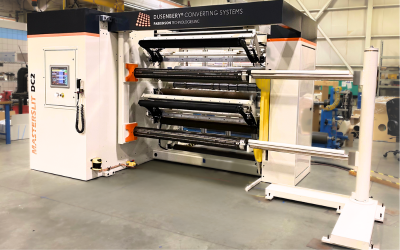

July 24 2023
Gabriela Martin, Marketing Coordinator , John Marold, Applications Engineer- Slitting Specialist

Investing in the right slitter rewinder is crucial for any business that converts wound materials into smaller rolls. With various options available in the market, selecting the perfect slitter rewinder which aligns with your specific needs can be a daunting task. In this comprehensive guide, we will walk you through the essential factors to consider when choosing a slitter rewinder for your business, ensuring a smart investment that enhances productivity and profitability.
Understanding Your Requirements:
It is important to begin by assessing your individual business requirements and goals. Consider factors such as the types of materials you work with, production volume, desired output quality, and any other unique specifications necessary to your manufacturing process. This initial evaluation will help you narrow down the options to find the most suitable slitter rewinder for your specific needs.
Material Compatibility: Different slitter rewinders are designed to handle specific materials such as paper, film, foil, or nonwovens. Ensure the machine you choose is compatible with the materials you typically work with. Consider aspects like width, thickness, tension control, and the ability to handle different material types, including sensitive or delicate ones.
Slitting Mechanisms: Evaluate the available slitting mechanisms, such as shear, razor, or crush cut. Each unique mechanism has its own advantages and is suitable for specific applications. Consider the quality of the finished slit edges, the complexity of setup and maintenance, and the flexibility to handle various slitting configurations.
Speed and Productivity: Production speed is a crucial factor to meeting demand requirements as efficiently as possible. Be sure to assess the required speed and evaluate the machine's capabilities in terms of maximum web speed, acceleration, deceleration, and overall productivity. Look for features that optimize uptime and minimize downtime, such as automatic roll changes or quick knife adjustments.
Automation and Technology: Advancements in automation and technology have greatly improved slitter rewinder operations and productivity. Look for features such as automatic core loading and unloading, web guiding systems, computerized control panels, process recipe creation and selection, data logging, and integration with other equipment. These features can significantly enhance efficiency and reduce operator error.
Safety Regulations: There are several ANSI and OSHA regulations and some specific to machine safeguarding in the material slitting industry. Look for compliance in manufacturing to the latest ANSI B11 and UL508A standards at a minimum to ensure guarding of pinch points. Area personnel protection should always be provided via scanners, safety mats, and light curtains, and machine risk assessment should also be considered. Good automated control practices for stored electrical and pneumatic or hydraulic energy is a must when determining a safe machine for operators to use daily.
Operator-Friendly Design: A well-designed slitter rewinder prioritizes operator safety, ergonomics, and ease of use. Look for features such as intuitive controls, safety mechanisms, easy access for maintenance and blade changes, and ergonomic workstations. Operator-friendly machines not only improve safety, but they also boost productivity by minimizing worker fatigue and reducing setup times.
Maintenance and Service: Consider the availability of spare parts, the reputation of the machinery OEM, and the level of after-sales service and support. A reliable OEM will provide timely maintenance, troubleshooting assistance, and spare parts availability, ensuring minimal downtime and optimal performance of your slitter rewinder.
Cost and Return on Investment: While price is a significant factor, it should not be the sole determining factor when deciding which slitter rewinder to purchase. Focus instead on the long-term return on investment (ROI) rather than basing your purchase decision on the upfront cost alone. Evaluate the machine's durability, performance, and the potential cost savings it could bring through increased efficiency, reduced waste, and improved quality as a whole.
Research and Consultation: Before making a final decision, conduct thorough research, read customer reviews, and seek recommendations from industry experts. Consult with slitter rewinder specialists who can provide valuable insights based on their own experience and expertise. Consider attending trade shows or industry events to see the machines in action and speak directly with manufacturers and suppliers.
Selecting the right slitter rewinder for your business is a critical decision to make that can impact your production quality and efficiency for years down the line. This is why it is so important to understand the essential factors listed above and take each of them into thoughtful consideration throughout the slitter rewinder purchase process.
Converting equipment is heavily utilized in many manufacturing industries, which is why Parkinson Technologies is a proud provider of high-quality slitter rewinder technology through our Dusenbery Converting Systems machinery line. For more information about our Dusenbery brand of slitter rewinders, or to find which slitter rewinder would be best suited to fit your unique business needs, please fill out the form below.